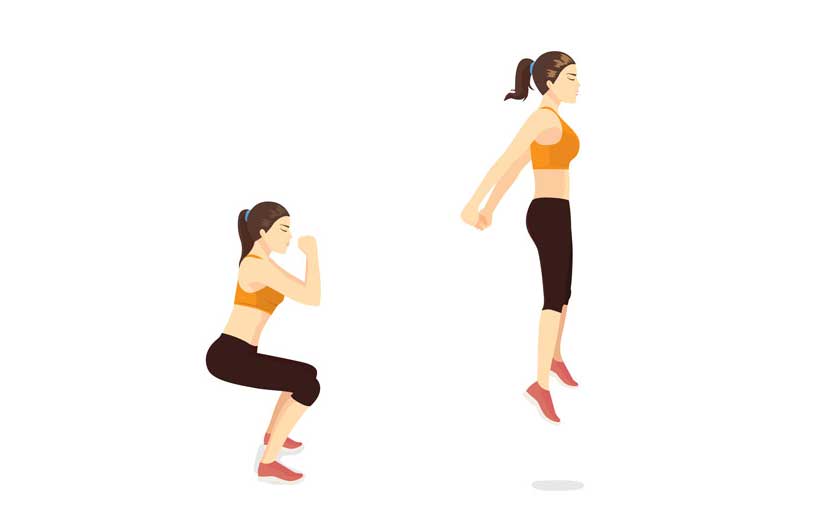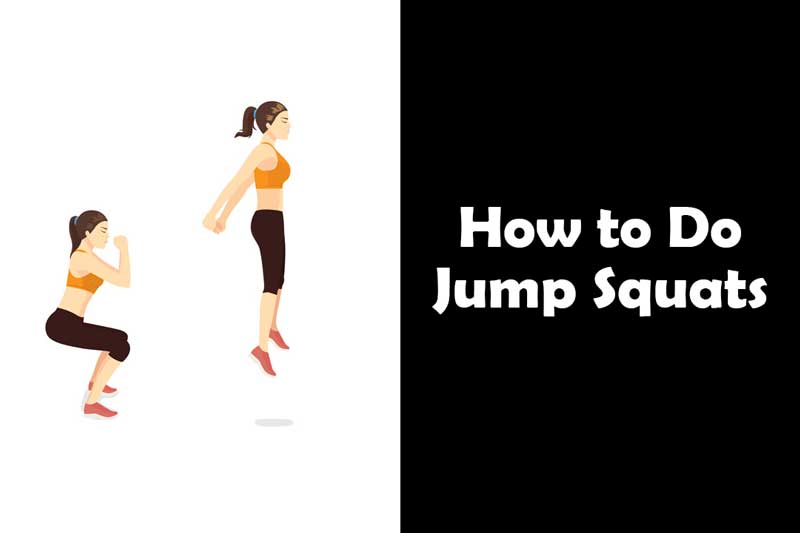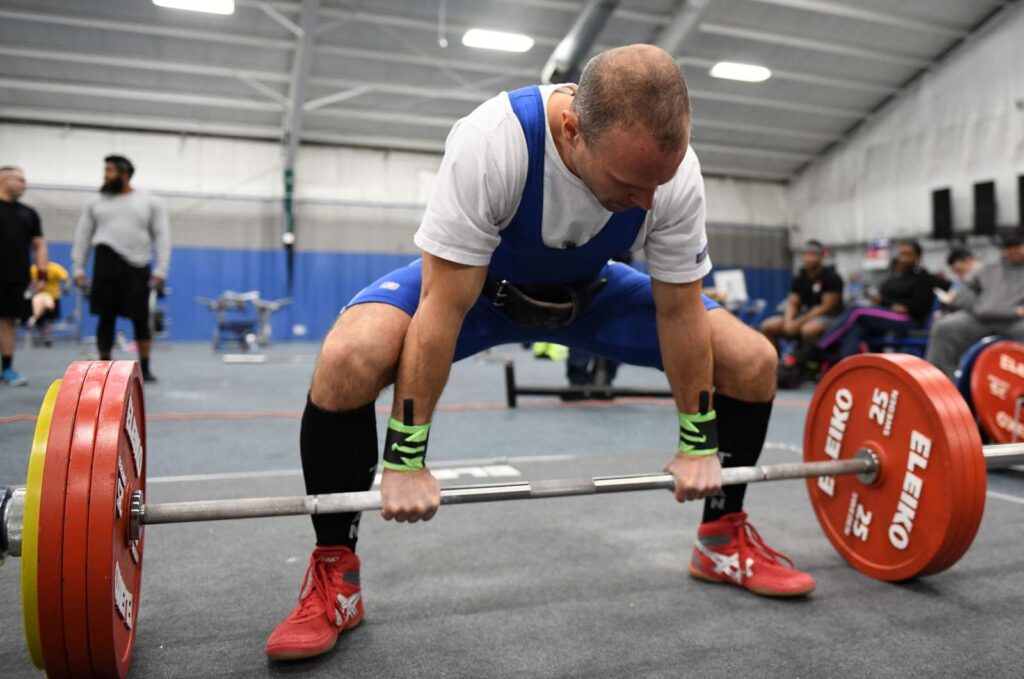Jump squats are a fantastic full body exercise that can help you build strength, power, and explosiveness especially in your lower body. They are a compound movement that engages multiple muscles and can be performed with various modifications to suit your fitness level.
In this article, we will guide you through the proper technique of jump squats, discuss the muscles worked, and explore different variations. Whether you’re a beginner or an advanced athlete, this exercise can be a valuable addition to your workout routine.
What are Jump Squats?
Jump squat is a dynamic exercise that combines a squatting motion with an explosive jump. Therefore, making it one of a great full body workout to include in your workout routine.
It is considered a great exercise to include in HIIT (High Intensity Interval Training).
They provide a wide range of benefits, including increased leg and core strength, improved power, enhanced athletic performance, and calorie burning. Whether you’re an athlete looking to enhance your vertical jump or a fitness enthusiast aiming to strengthen your lower body, jump squats are an excellent choice.
Benefits of Jump Squats

Jump squats offer numerous benefits for both the casual exerciser and the serious athlete. Some of the key advantages include:
1) Full Body Workout
Jump squats engage multiple muscle groups simultaneously, making them an efficient full-body exercise. They primarily target the quadriceps, hamstrings, glutes, and calves, but also activate the core, lower back, and upper body muscles (especially arms).
It also engage a good amount of cardiovascular muscles and activity.
2) Strength and Power
By incorporating explosive jumps into the squatting motion, jump squats help build strength and power in the lower body. The rapid extension of the legs during the jump phase activates the fast-twitch muscle fibers, leading to increased muscle development and power output.
3) Cardiovascular Conditioning
Jump squats elevate your heart rate and contribute to cardiovascular conditioning. Hence, they promote fat burning and improve cardiovascular endurance, making them an effective component of high-intensity interval training (HIIT) or circuit training routines.
4) Functional Movement
Jump squats mimic movements required in various sports and activities, such as jumping, landing, and quick changes in direction. By training these functional movements, you can improve your athletic performance and reduce the risk of injuries.
5) Versatile Exercise
Jump squat is a very versatile exercise. You can perform jump squats anywhere, let it be your home, gym or while travelling. It is also one of the best home workouts that burns calories fast. Include it in your full body workout or leg workout, choice is yours.
Muscles Worked
Jump squats target several major muscle groups in the lower body. These include:
- Quadriceps: The quadriceps muscles, located at the front of the thigh, are the primary muscles worked during jump squats. They are responsible for extending the knee joint and providing power during the jumping phase.
- Hamstrings: The hamstrings, located at the back of the thigh, act as stabilizers during jump squats. They assist in controlling the descent and contribute to the explosive upward movement.
- Glutes: The gluteal muscles, including the gluteus maximus, medius, and minimus, are activated during both the squatting and jumping phases of the exercise. They help extend the hip joint and provide power during the explosive jump.
- Calves: The calf muscles, specifically the gastrocnemius and soleus, are involved in the push-off during the jumping phase of jump squats. They assist in generating force and contribute to the explosive power of the exercise.
- Core: The movement of squatting and then jumping high requires high core muscles activation. The more reps you do the more the muscles around the abdomen are activated.
How to do Jump Squats (Proper Technique)
To perform jump squats correctly, follow these steps:
- Stand with your feet shoulder-width apart and your toes slightly turned out.
- Lower your body into a squat position by bending your knees and hips, keeping your chest lifted and your back straight.
- Once you reach the bottom of the squat, explode upward by extending your legs and pushing off the ground with force.
- As you jump, swing your arms backwards (behind your back) or upwards in the air (above your head) to generate momentum and height.
- Land softly on the balls of your feet, absorbing the impact through your legs and keeping your knees slightly bent.
- Immediately go into the next repetition by descending into the squat position and repeating the explosive jump.
It’s important to maintain proper form throughout the exercise. Keep your core engaged, maintain a neutral spine, and land softly to minimize stress on your joints.
Advanced Variations
For those looking to challenge themselves further, here are some advanced variations of jump squats:
Weighted Jump Squats
Hold dumbbells or a barbell on your shoulders to increase the resistance and intensity of the exercise. This variation adds an extra challenge to your lower body muscles.
Depth Jump Squats
Start by stepping off a box or platform and immediately perform a jump squat upon landing. This variation enhances power and explosiveness by incorporating a reactive element.
Plyometric Jump Squats
Instead of a traditional squat, perform a quick and explosive squat jump, trying to achieve maximum height with each repetition. Plyometric jump squat focuses on developing vertical jump power.
Easier Variations
If you’re new to jump squats or need a modification due to physical limitations, try these easier variations:
Bodyweight Squats
Perform regular squats without the jumping motion. Focus on maintaining proper form and gradually increase the depth of your squats as you gain strength.
Box Jump Squats
Step onto a low box or step, then perform a squat upon landing. This variation reduces the impact and allows for better control during the jumping phase.
Assisted Jump Squats
Use a resistance band or a TRX suspension trainer for assistance. The band or trainer will provide support as you perform the jump squats, making them easier on your joints and muscles.
You might also wanna check out:
Incorporating Jump Squats into Your Workout Routine
To include jump squats in your workout routine, consider the following tips:
- Warm-Up: Prior to performing jump squats, engage in a dynamic warm-up routine to prepare your muscles and joints. Incorporate exercises such as leg swings, hip rotations, and bodyweight squats.
- Start Slow: If you’re new to jump squats, begin with the easier variations and gradually progress to more advanced versions as your strength and technique improve.
- Combine with Other Exercises: Include jump squats as part of a well-rounded lower body workout routine. Furthermore, pair them with exercises like lunges, deadlifts, and step-ups for a comprehensive workout.
- Interval Training: Use jump squats in a high-intensity interval training (HIIT) format. Alternate between periods of intense jump squats and active recovery exercises to maximize calorie burn and cardiovascular conditioning.
How Much to Do?
The number of jump squats you should do depends on your fitness level and goals. Start with a manageable number of repetitions and gradually increase as you become more comfortable and stronger.
Aim for 2-3 sets of 10-15 repetitions, with a rest period of 1-2 minutes between sets.
If you are aiming to burn more calories, then increase your reps per set. Do 20-30 reps per set.
How Often to Do?
The frequency of this exercise will vary based on your overall training program and recovery capacity.
For most individuals, performing jump squats 2-3 times per week as part of a well-structured workout routine is sufficient. However, listen to your body and adjust the frequency according to your individual needs and goals.
Common Mistakes to Avoid
To ensure you perform jump squats safely and effectively, avoid these common mistakes:
- Poor Form: Maintain proper form throughout the exercise. Avoid rounding your back, collapsing your knees inward, or allowing your heels to lift off the ground.
- Landing Improperly: Land softly and quietly on the balls of your feet, with your knees slightly bent. Avoid landing with locked knees or flat feet, as this can increase the risk of injury.
- Not Engaging the Core: Keep your core muscles engaged throughout the movement. This helps stabilize your body and protect your lower back.
- Using Excessive Momentum: Focus on generating power from your leg muscles rather than relying on excessive arm swinging or momentum. This ensures you’re targeting the intended muscles effectively.
Tips for Success
Follow these tips to maximize the benefits of jump squats:
- Progress Gradually: Start with the variations that match your current fitness level and gradually progress to more challenging versions as you become stronger and more proficient.
- Listen to Your Body: Pay attention to any pain or discomfort during the exercise. If something doesn’t feel right, modify the movement or seek guidance from a fitness professional.
- Combine with Strength Training: Incorporate jump squats into a comprehensive strength training program that targets all major muscle groups. This will help you achieve a balanced physique and enhance overall athletic performance.
- Rest and Recover: Allow your body ample time to recover between jump squat sessions. Rest is crucial for muscle growth and injury prevention.
- Stay Consistent: Consistency is key when it comes to seeing progress. Incorporate jump squats into your regular workout routine and stick to it for optimal results.
Conclusion
Jump squat is a versatile exercise that can help you develop strength, power, and explosiveness in your lower body. Also, by incorporating jump squats into your workout routine, you can engage multiple muscle groups, improve athletic performance, and enhance cardiovascular conditioning.
Remember to start with proper form, gradually progress, and listen to your body. Whether you’re a beginner or an advanced athlete, jump squat can be an effective addition to your fitness regimen.
And never forget to Say Yes to Strength!
FAQs
1. Is jump squat suitable for beginners?
Yes, jump squat can be modified to suit beginners. Starting with bodyweight squat or box jump squat can help build strength and technique before progressing to more advanced variations.
2. Can jump squat help increase vertical jump height?
Yes, jump squat is a great exercise for improving vertical jump height. By training explosive power and lower body strength, you can enhance your jumping abilities.
3. Can jump squat help with weight loss?
Jump squat can contribute to weight loss by burning calories and increasing cardiovascular conditioning. However, they should be combined with a balanced diet and overall fitness program for optimal results.
4. Should I consult a fitness professional before incorporating jump squat into my routine?
If you have any pre-existing medical conditions or concerns, it’s advisable to consult a fitness professional or healthcare provider before starting any new exercise program.
5. Can jump squat cause knee pain?
Jump squat performed with proper form and technique should not cause knee pain. However, if you experience discomfort or pain in your knees, it’s essential to evaluate your form and modify the exercise accordingly.





